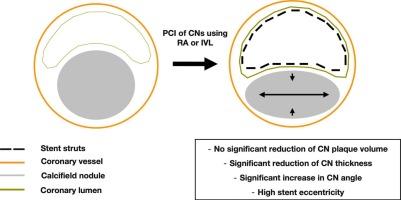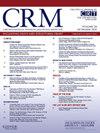Comparison of interventional treatment options for coronary calcified nodules: A sub-analysis of the ROTA.shock trial
IF 1.6
Q3 CARDIAC & CARDIOVASCULAR SYSTEMS
引用次数: 0
Abstract
Background
The optimal treatment for coronary calcified nodules (CNs) is still unclear. The aim of this study was to compare the modification of these lesions by coronary intravascular lithotripsy (IVL) and rotational atherectomy (RA) using optical coherence tomography (OCT).
Methods
ROTA.shock was a 1:1 randomized, prospective, double-arm multi-center non-inferiority trial that compared the use of IVL and RA with percutaneous coronary intervention (PCI) in severely calcified lesions. In 19 of the patients out of this study CNs were detected by OCT in the target lesion and were treated by either IVL or RA.
Results
The mean angle of CNs was significantly larger in final OCT scans than before RA (92 ± 17° vs. 68 ± 7°; p = 0.01) and IVL (89 ± 18° vs. 60 ± 10°; p = 0.03). The CNs were thinner upon final scans than in initial native scans (RA: 17.8 ± 7.8 mm vs. 38.6 ± 13.1 mm; p = 0.02; IVL: 16.5 ± 9.0 mm vs. 37.2 ± 14.3 mm; p = 0.02). Nodule volume did not differ significantly between native and final OCT scans (RA: 0.66 ± 0.12 mm3 vs. 0.61 ± 0.33 mm3; p = 0.68; IVL: 0.64 ± 0.19 mm3 vs. 0.68 ± 0.22 mm3; p = 0.74). Final stent eccentricity was high with 0.62 ± 0.10 after RA and 0.61 ± 0.09 after IVL.
Conclusion
RA or IVL are unable to reduce the volume of the calcified plaque. CN modulation seems to be mainly induced by the stent implantation and not by RA or IVL.

冠状动脉钙化结节介入治疗方案的比较:ROTA.shock试验的子分析
背景冠状动脉钙化结节(CNs)的最佳治疗方法尚不明确。这项研究的目的是比较冠状动脉血管内碎石术(IVL)和旋转动脉瘤切除术(RA)利用光学相干断层扫描(OCT)改变这些病变的效果。方法ROTA.shock是一项1:1随机、前瞻性、双臂多中心非劣效性试验,比较了在严重钙化病变中使用IVL和RA与经皮冠状动脉介入治疗(PCI)的效果。结果在最终的 OCT 扫描中,CN 的平均角度明显大于 RA(92 ± 17° vs. 68 ± 7°;p = 0.01)和 IVL(89 ± 18° vs. 60 ± 10°;p = 0.03)前。最终扫描时,CN 比初始原位扫描时更薄(RA:17.8 ± 7.8 mm vs. 38.6 ± 13.1 mm;p = 0.02;IVL:16.5 ± 9.0 mm vs. 37.2 ± 14.3 mm;p = 0.02)。结节体积在原始扫描和最终 OCT 扫描之间没有明显差异(RA:0.66 ± 0.12 mm3 vs. 0.61 ± 0.33 mm3;p = 0.68;IVL:0.64 ± 0.19 mm3 vs. 0.68 ± 0.22 mm3;p = 0.74)。最终支架偏心率较高,RA 后为 0.62 ± 0.10,IVL 后为 0.61 ± 0.09。CN调节似乎主要是由支架植入引起的,而不是由RA或IVL引起的。
本文章由计算机程序翻译,如有差异,请以英文原文为准。
求助全文
约1分钟内获得全文
求助全文
来源期刊

Cardiovascular Revascularization Medicine
CARDIAC & CARDIOVASCULAR SYSTEMS-
CiteScore
3.30
自引率
5.90%
发文量
687
审稿时长
36 days
期刊介绍:
Cardiovascular Revascularization Medicine (CRM) is an international and multidisciplinary journal that publishes original laboratory and clinical investigations related to revascularization therapies in cardiovascular medicine. Cardiovascular Revascularization Medicine publishes articles related to preclinical work and molecular interventions, including angiogenesis, cell therapy, pharmacological interventions, restenosis management, and prevention, including experiments conducted in human subjects, in laboratory animals, and in vitro. Specific areas of interest include percutaneous angioplasty in coronary and peripheral arteries, intervention in structural heart disease, cardiovascular surgery, etc.
 求助内容:
求助内容: 应助结果提醒方式:
应助结果提醒方式:


